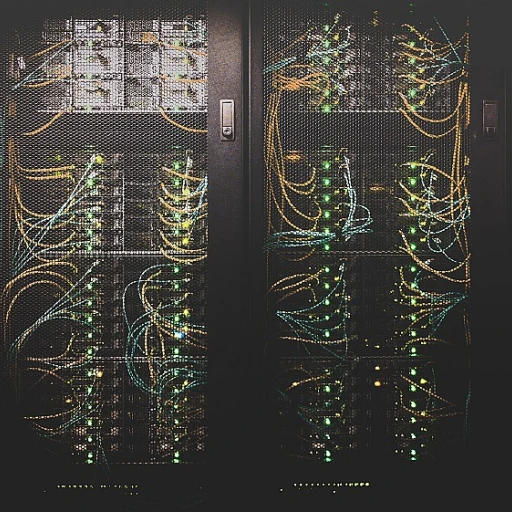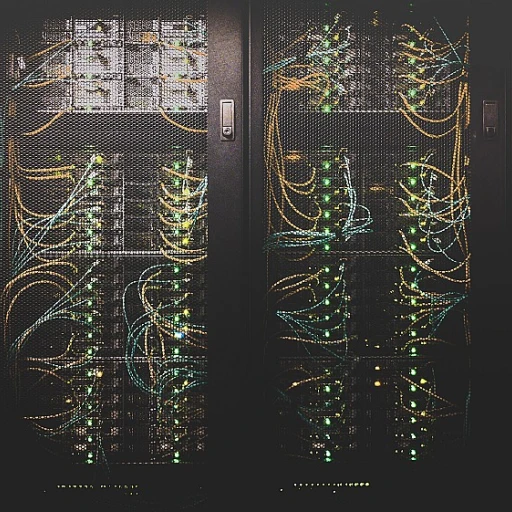
Emerging Trends in Custom Software
Shifting Patterns in Custom Software
In the ever-busy world of custom software development, there's a buzz around embracing new technology trends. Businesses no longer settle for one-size-fits-all solutions. They're after software that not only solves problems but also gives them a competitive edge. Companies are stepping up to the plate, offering bespoke software that’s as unique as their client’s thumbprints. In this evolving environment, some trends are absolutely standing out:- Edge Computing and Cloud: With the rise of cloud-native and edge computing technologies, companies are leaning into systems that improve processing speed and data handling even in real-time scenarios. The pairing of these forces is changing the very face of custom software development.
- Machine Learning and AI: We can't talk about software today without a nod to artificial intelligence. Developers are using AI across applications to boost decision making, efficiency, and user experience. It’s proving pivotal in personalized solutions, automations, and security enhancements.
- Low Code Platforms: A lifesaver for many businesses, low code is making it easier for companies to create apps. It’s cutting down development time significantly and making software solutions more accessible. But it doesn't stop developers from crafting intricate systems when needed.
- Focus on Security: With the increasing amount of data being processed, security is no longer an add-on. It's ingrained in every part of the development process. Developers are championing for sturdy defenses to cope with cyber threats.
- User Experience Oriented: Software is moving beyond just functionality. The user experience is a crucial piece of the puzzle, reshaping how software developers approach design. There's a relentless push towards intuitive, user-friendly interfaces that engage and captivate.
The Role of Artificial Intelligence in Custom Software
The Fusion of AI and Software Development
Artificial intelligence isn't just a buzzword now; it's actively shaping how software is designed and developed. Think of AI as a valuable teammate for developers, speeding up processes and enabling solutions we wouldn't have imagined a decade ago. From predictive text in mobile apps to complex data analysis in business software, AI is redefining the software development scene. AI helps developers tackle complex problems—like transforming mountains of raw data into actionable insights through machine learning algorithms. This is especially beneficial in industries with extensive data needs, from retail supply chains to digital security systems. Companies are also leveraging AI for predictive analytics to enhance user experience. By anticipating user actions or preferences, businesses can offer applications that feel intuitive and responsive. AI-driven software solutions are set to become even more critical as they evolve to meet the growing demands of real-time data processing, pushing the boundaries of app development.Addressing Industry Needs with Custom Software
Businesses differ, and so do their software needs. Custom software allows companies to create solutions tailored to specific demands, whether it's enhancing productivity, beefing up security, or providing detailed analytics. Different sectors require different solutions. For example, a healthcare provider may focus on secure data transfer and real-time patient monitoring, while a manufacturing company might emphasize supply chain efficiency and automated decision-making processes. Custom software development allows businesses to address these distinct requirements exquisitely. The trend towards digital transformation isn't going away—if anything, it's accelerating. By embracing custom solutions, companies can ensure they're ready to step into the future with software that meets their exact needs.Hurdles Faced in Custom Software Development
Creating custom software isn't without its challenges. One significant issue is balancing complexity against ease-of-use. As developers add functionalities, maintaining a user-friendly interface can be tricky. Security is another concern. As businesses collect an increasing amount of user data, safeguarding this data from breaches is critical. Companies must ensure their software is secure at all levels, often requiring robust encryption and regular security assessments. Moreover, long-term maintenance and updates can pose challenges. Developers must ensure the software remains compatible with new technologies or platforms—a task easier said than done.Future Prospects for Developers
Developers have a bright road ahead as custom software becomes more integral to business strategies. The demand for skilled developers is surging with opportunities to specialize in emerging areas like cloud-native applications or edge computing. Developers who stay updated with the latest trends and continuously enhance their skillset can tap into promising career prospects. Future trends like low-code platforms also offer exciting possibilities, allowing developers to create sophisticated systems with greater efficiency. Learn more about the ongoing trends in custom software development by exploring the future of software development.Industry-Specific Custom Software Solutions
Customized Solutions for Various Industries
Custom software isn't just about building a cookie-cutter solution. It's about creating something that fits like a glove for each business sector.Take the healthcare industry, for example. Custom software development enables the creation of applications that handle patient data with the utmost care, ensuring both compliance with regulations and a smooth user experience. Advanced analytics and artificial intelligence might be used here to support better decision-making, as seen in real-time patient monitoring systems. For retail industries, custom applications often involve cloud-native solutions. These apps help track inventory and streamline supply chains. The need for high security cannot be overstated when handling sensitive data, and so developers must stay ahead of potential threats, often embracing edge computing to enhance system responsiveness. Manufacturing sectors are not left behind. They rely heavily on customized software to monitor operations, manage teams, and predict maintenance of machinery. The integration of machine learning often helps these companies reduce costs and boost efficiency in their processes. Custom software’s role in education can’t be ignored either. With the growing trend of digital classrooms, education technology companies focus on bespoke solutions that enhance the learning experience while managing huge datasets involving student records. In financial services, customer interactions and transaction security are crucial. Custom development tailors banking systems to provide both high-end services and safety, meeting both client and regulatory demands.
The Array of Customized Software in the Corporate World
Let's think about those small startups hoping to make big moves. They need software that can scale quickly with their growth. Larger corporations may look for custom something that'll integrate smoothly into their established systems, following trends like low code solutions which empower teams to control app development efficiently. So what's the takeaway here? Custom software is the chameleon of the tech world. Whether it's healthcare, education, finance, retail, or any other sector, the emphasis is on solutions that meet specific needs and improve business operations. Curious to learn about how "DevOps is Reshaping the Future of Software Development" and fits into this story of custom applications? Check it out right here, giving you more insight into these development trends: how devops is reshaping the future of software developmentChallenges in Developing Custom Software
Pitfalls and hiccups in Custom Software Development
Custom software development brings oh-so-many opportunities for businesses to really shine, but let’s not gloss over the stumbling blocks developers often face. These challenges can be real doozies, affecting those picture-perfect custom solutions that businesses dream about. Privacy concerns can’t be ignored, especially in our modern era where data is king. Companies need iron-clad security features to protect sensitive information. Failing on the security front can lead to breaches, with costly consequences both financially and reputation-wise, as stated by experts like SecureTech (source). Then there’s the ever-present cloud dilemma—how does your software secure data and make it accessible when needed? Striking the perfect balance is tough, and developers must stay in the loop with cloud trends to ensure their custom apps do it right. Real-time data processing is the name of the game, and it requires a robust system in place. Users crave data at their fingertips and any lag can become a headache. Hence, developers must nail the performance and reliability parts of the custom solution. Developers also have to dodge the bullet of technical debt. Piling up unresolved issues or shortcuts can trip up the system in the long run. Investment in proper planning can save businesses from nasty surprises down the road. User experience—such a critical piece of the puzzle! Without it, bespoke software risks losing the user's trust. Developers have to create intuitive and flexible experiences, working alongside UX designers who know their stuff. Bouncing onto the next hurdle—keeping up with tech advancements. Technology whips along at lightning speed. Machine learning, AI, and edge computing aren't just buzzwords; they're elements developers need to incorporate into the build when appropriate. Finally, let’s mention the communication gap. It crops up between the development team and those commissioning the software. Strong communication skills bridge this gap, ensuring that all requirements are well understood and designs align with business goals. In the wild world of custom software, these challenges are part of the game. Veteran developers can attest that overcoming them contributes not just to the software’s success, but also to their personal growth and the business as a whole.The Importance of User-Centric Design
Emphasizing User Experience in Today's Software
Custom software is evolving by leaps and bounds, especially when it comes down to the user experience. Developers now, more than ever, are putting themselves in the shoes of the users, aiming not just for functionality but also delight. This isn't just about making things look pretty. It's about intuitive and seamless interactions that feel like second nature to users. To achieve a superior user experience, businesses need to truly understand the needs and behaviors of their audience. This involves digging deep into data—analyzing what users want, how they behave, and what trips them up. It's almost like piecing together a puzzle, where each piece represents a smidgen of user feedback or digital behavior patterns.According to a study by Forrester, companies that invest in user experience have seen returns of up to 100 times the investment. Prioritizing user demands is not just a trend; it's a sound business strategy.
The Human Element in Tech Decisions
AI is playing a starring role in today’s software development, but at the heart of every great app or digital system is the human experience it nurtures. It's not enough for a program to be state-of-the-art; it must connect on a human level, fulfilling emotional and practical needs. Whether we’re talking about an app that redefines how supply chains are managed or digital systems for efficient business operations in real time, the human element cannot be overemphasized. Few things frustrate a user more than a clunky interface or an app that needs a Ph.D. to navigate. The future of software solutions rests on making technology accessible and enjoyable for everyone. This translates to practical application in businesses, where user-friendly data systems can lead to smoother operations and more effective decision-making.A Look Ahead for Developers
For developers eyeing the horizon, the future brings exciting challenges and opportunities. Embracing user-centric design means honing skills in low code development platforms or mastering the delicate art of app development that speaks effectively to users' desires. Cloud-native solutions are enabling software developers to create more responsive and scalable applications tailor-made for the modern user’s needs. Cloud technology and real-time data are progressing rapidly, demanding developers to stay sharp and adaptive. Companies that once relied on rigid systems now find flexibility, allowing them to keep pace with industry shifts. The tide is turning towards bespoke software that’s built from the ground up to prioritize user experiences – a trend that benefits both developers and end-users alike. So, as software pushes what’s possible with technology, it’s actually grounding itself in the human experience. The ones who will thrive in this future are those who place people at the center of their digital creations. It’s a thrilling time to be involved in software development, with endless potential for a brighter, more connected future.Future Prospects for Custom Software Developers
Opportunities for Growth and Innovation
As we look ahead, the future of custom software development is brimming with opportunities for growth and innovation. With the rapid pace of technological advancements, developers have the chance to create solutions that not only meet current business needs but also anticipate future demands. This forward-thinking approach is crucial as companies strive to stay competitive and responsive to changes in their industries.
Adapting to New Technologies
Developers will need to adapt to emerging technologies like artificial intelligence, machine learning, and edge computing. These tools offer the potential to enhance decision making and improve real-time data processing, which can significantly impact how businesses operate. As these technologies become more integrated into software solutions, developers will have to continuously update their skills to harness their full potential.
Embracing Cloud and Low-Code Solutions
The shift towards cloud-native applications is another trend that developers cannot ignore. Cloud solutions offer scalability and flexibility, allowing businesses to quickly adapt to changing needs. Additionally, the rise of low-code platforms is democratizing app development, enabling more people to participate in creating software solutions. This means developers will need to focus on more complex tasks that require specialized skills, leaving routine tasks to automated systems.
Addressing Security and User Experience
Security remains a top priority as businesses handle increasing amounts of sensitive data. Developers must prioritize building secure systems that protect against cyber threats. At the same time, user experience cannot be overlooked. As discussed earlier, a user-centric design is key to creating applications that are not only functional but also intuitive and enjoyable to use.
Industry-Specific Solutions
Custom software development will continue to offer industry-specific solutions that cater to unique business requirements. From healthcare to supply chain management, developers will need to understand the specific challenges and opportunities within each sector to deliver effective software solutions.
Long-Term Prospects for Developers
For developers, the future holds the promise of exciting projects and the chance to make a significant impact on businesses and industries. Staying informed about development trends and continuously learning new skills will be essential for success. By embracing these opportunities, developers can ensure they remain valuable assets in the ever-evolving world of software development.















